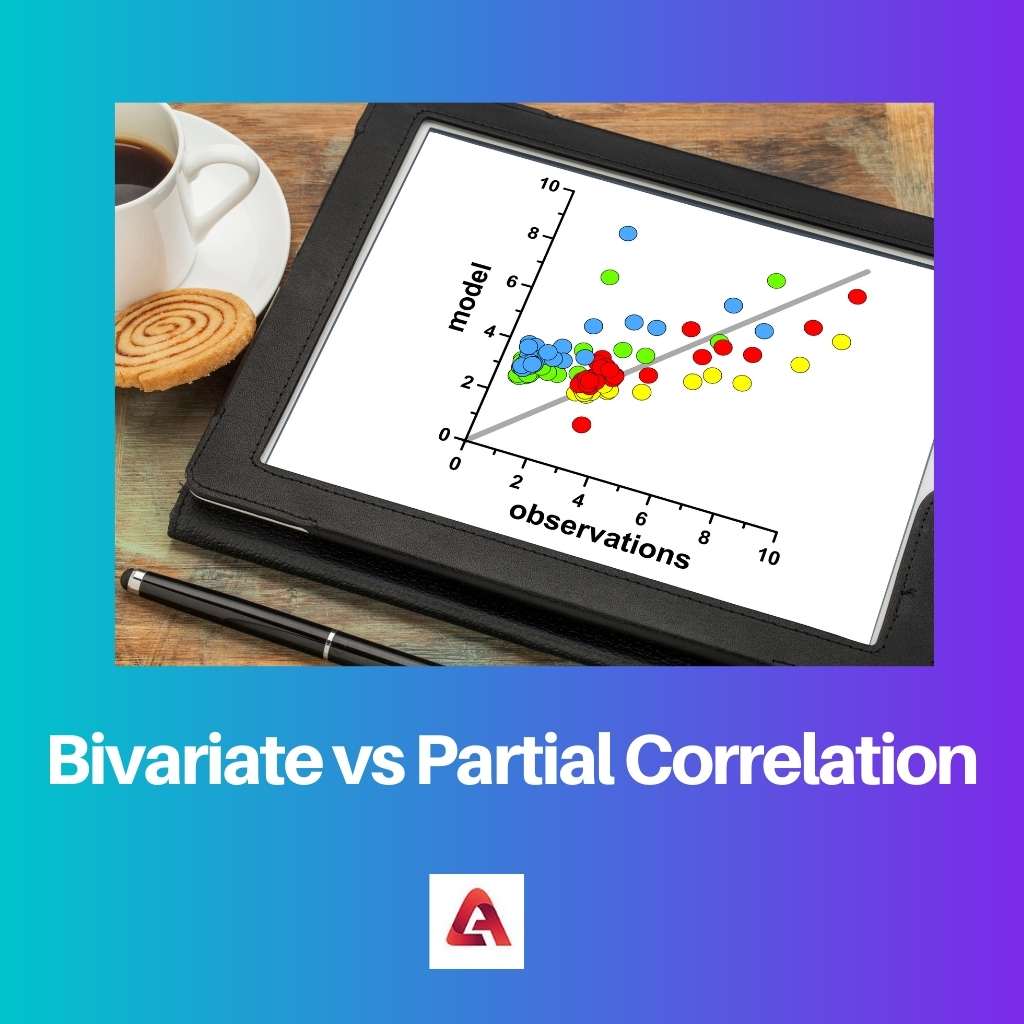Correlations are classified into two forms in statistics, i.e., bivariate and partial correlations. Correlation is the extent and direction of association of two variables – in other words, how effectively one can be figured from the other.
Shared relations between two variables can be positive, optimistic, or curvilinear. Numerical scales are used to measure and express it. Correlations are said to be positive when they increase simultaneously and negative when they decline in value.
Key Takeaways
- Bivariate correlation examines the relationship between two variables, whereas partial correlation assesses the connection after controlling for one or more variables.
- Bivariate correlation can be affected by confounding factors, but partial correlation removes their influence to provide clearer insights.
- Partial correlation is more complex to calculate and interpret than bivariate correlation, requiring additional statistical techniques.
Bivariate vs Partial Correlation
Bivariate correlation is a statistical method used to measure the strength and direction of the linear relationship between two variables. Partial correlation is a statistical method used to measure the relationship between two variables while controlling for the effects of some variables.

A bivariate correlation is applied to identify whether or not two variables are related. It assesses how variables change at the same time.
An examination through the bivariate method helps by exploring multiple elements simultaneously. This analysis’ tries to pinpoint the linear relationship between two variables.
Partial correlation differs from bivariate; it removes the extra variable to signify the correlation between two variables. This method helps compute the correlation between variables by striking out the influence of the third variable.
It can perform admirably in multiple regression. Under this type of correlation, valuable data is accumulated to discover hidden ties and identify correlations.
Comparison Table
What is Bivariate Correlation?
A bivariate correlation is appropriate for evaluating simple assumptions of linkage and causality. A bivariate analysis goes further in description; it examines numerous relationships between multiple variables simultaneously.
The length and width of an object are two examples of bivariate association.
When one variable is arbitrary, or either variable is difficult to measure, bivariate correlation can assist in understanding and anticipating the result of other variables.
A bivariate correlation can be measured using a variety of tests, such as the scatterplot and the Pearson Product-Moment Correlation test. A correlation matrix is used to represent the test findings of this correlation.
A correlation is a single value between -1 and +1 that reflects the intensity of linkage or co-occurrence between two variables.
This statistic, which quantifies the strength of linkage, is known as the correlation coefficient, and it is commonly symbolized by the letter ‘r’.
Pearson product-moment correlation coefficient is the second name for the correlation coefficient between two continuous-level variables.
A positive r value denotes a positive connection between the two variables (the more excellent A, the more excellent B). In contrast, a negative r value denotes a negative relationship (the larger A, the more minor B).
A correlation value of 0 shows no relation between the components. Correlations, on the other hand, are limited to linear relationships between variables. A non-linear relationship may exist even if the correlation coefficient is zero.
What is Partial Correlation?
When the influence of related variables is removed from the equation, the correlation between two variables is termed partial correlation. It performs admirably in multiple regression.
It is a technique for explaining the relation between independent variables while ignoring the impact of another variable inside the relationship.
It accumulates variables to determine whether or not they exhibit collective behaviour. Partial correlation is helpful in discovering concealed connections and detecting deceptive correlations.
The relationship between a person’s weight and height after controlling the value of age illustrates partial correlation.
Suppose we wish to determine how strong a relationship is there between two variables of interest by the use of their correlation coefficient. In that case, it will provide misleading results if there is one more variable, which is a puzzling variable and is numerically related to both variables of interest.
Controlling the influencing variable, which is accomplished by calculating the partial correlation coefficient, can help in the avoidance of misleading data.
This is why multiple regression includes extra right-side variables; however, while numerous regression gives results that are not biased regarding impact size, it will not give a numerical value for the amount of relationship between two variables of interest.
The partial correlation has a value between –1 and 1. The value –1 denotes an ideal negative correlation controlling for specific variables, 1 indicates a perfect positive linear relationship, and 0 indicates the absence of a linear relationship.
Main Differences Between Bivariate and Partial Correlation
- A bivariate correlation determines whether two variables are connected or not. Partial correlation, on the other hand, is used to quantify the relationship after correcting for other variables.
- Bivariate correlation is the measurement or analysis of two variables. However, partial correlation assesses the degree to which additional factors are present.
- Variables such as X and Y are frequently used in bivariate correlation. Partial correlation involves using random variables, such as X and Y, X and Z, or Y and Z.
- The symbol for Bivariate correlation is Pearson’s ‘r’ (R), and for partial correlation, it is ‘rYX.W’.
- Bivariate correlation is used to calculate the correlation coefficient, which provides the degree of a link between two linear variables. After adjusting for one or more variables, partial correlation is used to get correlation coefficients.
- https://onlinelibrary.wiley.com/doi/abs/10.1002/jrsm.1126
- https://www.tandfonline.com/doi/abs/10.1207/s15327906mbr3803_02


